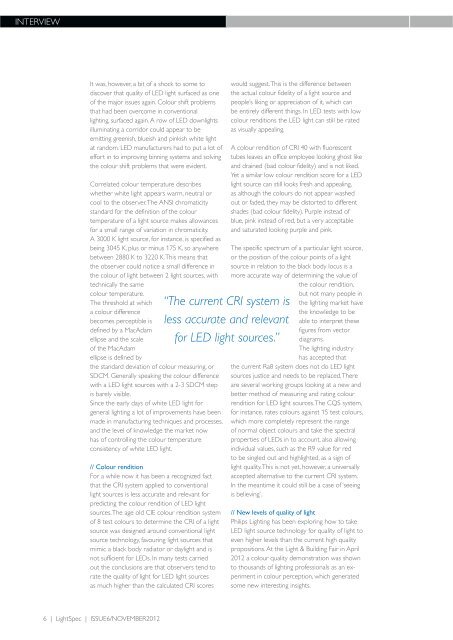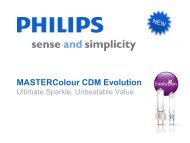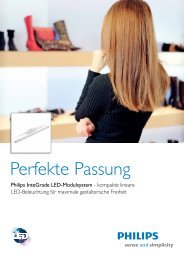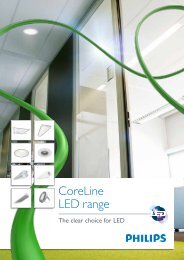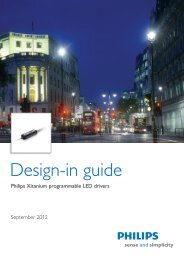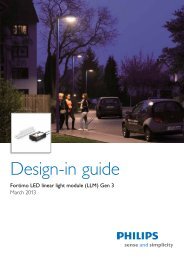Quality of light and the - Philips Lighting
Quality of light and the - Philips Lighting
Quality of light and the - Philips Lighting
You also want an ePaper? Increase the reach of your titles
YUMPU automatically turns print PDFs into web optimized ePapers that Google loves.
iNtERViEW<br />
it was, however, a bit <strong>of</strong> a shock to some to<br />
discover that quality <strong>of</strong> LED <strong>light</strong> surfaced as one<br />
<strong>of</strong> <strong>the</strong> major issues again. Colour shift problems<br />
that had been overcome in conventional<br />
<strong>light</strong>ing, surfaced again. a row <strong>of</strong> LED down<strong>light</strong>s<br />
illuminating a corridor could appear to be<br />
emitting greenish, blueish <strong>and</strong> pinkish white <strong>light</strong><br />
at r<strong>and</strong>om. LED manufacturers had to put a lot <strong>of</strong><br />
effort in to improving binning systems <strong>and</strong> solving<br />
<strong>the</strong> colour shift problems that were evident.<br />
Correlated colour temperature describes<br />
whe<strong>the</strong>r white <strong>light</strong> appears warm, neutral or<br />
cool to <strong>the</strong> observer. <strong>the</strong> aNsi chromaticity<br />
st<strong>and</strong>ard for <strong>the</strong> definition <strong>of</strong> <strong>the</strong> colour<br />
temperature <strong>of</strong> a <strong>light</strong> source makes allowances<br />
for a small range <strong>of</strong> variation in chromaticity.<br />
a 3000 K <strong>light</strong> source, for instance, is specified as<br />
being 3045 K, plus or minus 175 K, so anywhere<br />
between 2880 K to 3220 K. this means that<br />
<strong>the</strong> observer could notice a small difference in<br />
<strong>the</strong> colour <strong>of</strong> <strong>light</strong> between 2 <strong>light</strong> sources, with<br />
technically <strong>the</strong> same<br />
colour temperature.<br />
<strong>the</strong> threshold at which<br />
a colour difference<br />
becomes perceptible is<br />
defined by a Macadam<br />
ellipse <strong>and</strong> <strong>the</strong> scale<br />
<strong>of</strong> <strong>the</strong> Macadam<br />
ellipse is defined by<br />
<strong>the</strong> st<strong>and</strong>ard deviation <strong>of</strong> colour measuring, or<br />
sDCM. Generally speaking <strong>the</strong> colour difference<br />
with a LED <strong>light</strong> sources with a 23 sDCM step<br />
is barely visible.<br />
since <strong>the</strong> early days <strong>of</strong> white LED <strong>light</strong> for<br />
general <strong>light</strong>ing a lot <strong>of</strong> improvements have been<br />
made in manufacturing techniques <strong>and</strong> processes,<br />
<strong>and</strong> <strong>the</strong> level <strong>of</strong> knowledge <strong>the</strong> market now<br />
has <strong>of</strong> controlling <strong>the</strong> colour temperature<br />
consistency <strong>of</strong> white LED <strong>light</strong>.<br />
// Colour rendition<br />
For a while now it has been a recognized fact<br />
that <strong>the</strong> CRi system applied to conventional<br />
<strong>light</strong> sources is less accurate <strong>and</strong> relevant for<br />
predicting <strong>the</strong> colour rendition <strong>of</strong> LED <strong>light</strong><br />
sources. <strong>the</strong> age old CiE colour rendition system<br />
<strong>of</strong> 8 test colours to determine <strong>the</strong> CRi <strong>of</strong> a <strong>light</strong><br />
source was designed around conventional <strong>light</strong><br />
source technology, favouring <strong>light</strong> sources that<br />
mimic a black body radiator or day<strong>light</strong> <strong>and</strong> is<br />
not sufficient for LEDs. in many tests carried<br />
out <strong>the</strong> conclusions are that observers tend to<br />
rate <strong>the</strong> quality <strong>of</strong> <strong>light</strong> for LED <strong>light</strong> sources<br />
as much higher than <strong>the</strong> calculated CRi scores<br />
6 | Lightspec | issuE6/NoVEMBER2012<br />
“The current CRI system is<br />
less accurate <strong>and</strong> relevant<br />
for LED <strong>light</strong> sources.”<br />
would suggest. this is <strong>the</strong> difference between<br />
<strong>the</strong> actual colour fidelity <strong>of</strong> a <strong>light</strong> source <strong>and</strong><br />
people’s liking or appreciation <strong>of</strong> it, which can<br />
be entirely different things. in LED tests with low<br />
colour renditions <strong>the</strong> LED <strong>light</strong> can still be rated<br />
as visually appealing.<br />
a colour rendition <strong>of</strong> CRi 40 with fluorescent<br />
tubes leaves an <strong>of</strong>fice employee looking ghost like<br />
<strong>and</strong> drained (bad colour fidelity) <strong>and</strong> is not liked.<br />
yet a similar low colour rendition score for a LED<br />
<strong>light</strong> source can still looks fresh <strong>and</strong> appealing,<br />
as although <strong>the</strong> colours do not appear washed<br />
out or faded, <strong>the</strong>y may be distorted to different<br />
shades (bad colour fidelity). Purple instead <strong>of</strong><br />
blue, pink instead <strong>of</strong> red, but a very acceptable<br />
<strong>and</strong> saturated looking purple <strong>and</strong> pink.<br />
<strong>the</strong> specific spectrum <strong>of</strong> a particular <strong>light</strong> source,<br />
or <strong>the</strong> position <strong>of</strong> <strong>the</strong> colour points <strong>of</strong> a <strong>light</strong><br />
source in relation to <strong>the</strong> black body locus is a<br />
more accurate way <strong>of</strong> determining <strong>the</strong> value <strong>of</strong><br />
<strong>the</strong> colour rendition,<br />
but not many people in<br />
<strong>the</strong> <strong>light</strong>ing market have<br />
<strong>the</strong> knowledge to be<br />
able to interpret <strong>the</strong>se<br />
figures from vector<br />
diagrams.<br />
<strong>the</strong> <strong>light</strong>ing industry<br />
has accepted that<br />
<strong>the</strong> current Ra8 system does not do LED <strong>light</strong><br />
sources justice <strong>and</strong> needs to be replaced. <strong>the</strong>re<br />
are several working groups looking at a new <strong>and</strong><br />
better method <strong>of</strong> measuring <strong>and</strong> rating colour<br />
rendition for LED <strong>light</strong> sources. <strong>the</strong> CQs system,<br />
for instance, rates colours against 15 test colours,<br />
which more completely represent <strong>the</strong> range<br />
<strong>of</strong> normal object colours <strong>and</strong> take <strong>the</strong> spectral<br />
properties <strong>of</strong> LEDs in to account, also allowing<br />
individual values, such as <strong>the</strong> R9 value for red<br />
to be singled out <strong>and</strong> high<strong>light</strong>ed, as a sign <strong>of</strong><br />
<strong>light</strong> quality. this is not yet, however, a universally<br />
accepted alternative to <strong>the</strong> current CRi system.<br />
in <strong>the</strong> meantime it could still be a case <strong>of</strong> ‘seeing<br />
is believing’.<br />
// New levels <strong>of</strong> quality <strong>of</strong> <strong>light</strong><br />
<strong>Philips</strong> <strong>Lighting</strong> has been exploring how to take<br />
LED <strong>light</strong> source technology for quality <strong>of</strong> <strong>light</strong> to<br />
even higher levels than <strong>the</strong> current high quality<br />
propositions. at <strong>the</strong> Light & Building Fair in april<br />
2012 a colour quality demonstration was shown<br />
to thous<strong>and</strong>s <strong>of</strong> <strong>light</strong>ing pr<strong>of</strong>essionals as an experiment<br />
in colour perception, which generated<br />
some new interesting insights.<br />
in Retail <strong>light</strong>ing quality <strong>of</strong> <strong>light</strong> has always been<br />
a very important factor in <strong>the</strong> choice <strong>of</strong> a <strong>light</strong>ing<br />
installation. this is particularly true when material<br />
or fabric with rich colours is being illuminated.<br />
Retailers recognize <strong>the</strong> important role good<br />
<strong>light</strong>ing can play in drawing customers in to <strong>the</strong>ir<br />
stores <strong>and</strong> are very much aware <strong>of</strong> <strong>the</strong> choices<br />
<strong>the</strong>y can make for a <strong>light</strong> source with a particular<br />
colour temperature <strong>and</strong> colour rendition.<br />
Generally speaking, in Europe, warmer <strong>light</strong><br />
sources <strong>of</strong> around 3000 K with excellent colour<br />
rendition have been <strong>the</strong> preferred choice for<br />
many chains <strong>of</strong> shops, as <strong>the</strong>y are welcoming<br />
<strong>and</strong> invite <strong>the</strong> customer to come in <strong>and</strong> linger.<br />
<strong>Philips</strong> <strong>Lighting</strong> has had years <strong>of</strong> experience <strong>of</strong><br />
discussing <strong>the</strong> effects <strong>and</strong> merits <strong>of</strong> different<br />
<strong>light</strong> sources with major retailers in Europe <strong>and</strong><br />
recognizes <strong>the</strong> trend towards a warm ambient<br />
<strong>light</strong>ing effect, giving <strong>the</strong> colours <strong>of</strong> materials,<br />
clo<strong>the</strong>s <strong>and</strong> o<strong>the</strong>r fabrics a warm, saturated glow.<br />
But whereas <strong>the</strong> warm appearance is very much<br />
appreciated for colours, <strong>the</strong>re is still a preference<br />
for white to be white <strong>and</strong> not necessarily <strong>of</strong>fwhite,<br />
creamy or yellowish in appearance.<br />
a conventional <strong>light</strong> source with 3000 K <strong>and</strong> a<br />
high colour rendition will make all <strong>the</strong> colours,<br />
including white in <strong>the</strong> display seem warm. in<br />
<strong>the</strong> same way a 4000 K <strong>light</strong> source will make<br />
white <strong>and</strong> all <strong>the</strong> colours appear fresh <strong>and</strong><br />
cooler. yet what is <strong>of</strong>ten subconsciously wanted<br />
is that unique combination <strong>of</strong> bright, cool white<br />
toge<strong>the</strong>r with warm, saturated colours.<br />
using <strong>the</strong> extensive experience <strong>of</strong> colour<br />
appearance <strong>and</strong> colour appreciation, <strong>Philips</strong> has<br />
identified an intriguing way <strong>of</strong> optimizing <strong>the</strong> <strong>light</strong><br />
spectrum, which combined with <strong>the</strong> perfect beam<br />
homogeneity gives a new colour experience.<br />
this patented solution gives <strong>the</strong> appearance <strong>of</strong><br />
combining two fixed colour temperatures within<br />
one <strong>light</strong> source. this same <strong>light</strong> source can make<br />
white appear crisp <strong>and</strong> cool, whilst <strong>the</strong> o<strong>the</strong>r colours<br />
in <strong>the</strong> goods on display will appear warm,<br />
giving <strong>the</strong> effect <strong>of</strong> a completely natural scene.<br />
<strong>the</strong> appearance <strong>of</strong> colour temperature contrast<br />
in one lamp.<br />
an ideal <strong>light</strong> source for Retail spot <strong>light</strong>ing?<br />
<strong>Philips</strong> is considering applying this new<br />
patented technology to <strong>the</strong> Fortimo LED sLM<br />
modules in <strong>the</strong> near future.<br />
www.philips.com/<strong>light</strong>spec<br />
issuE6/NoVEMBER2012 | Lightspec | 7


